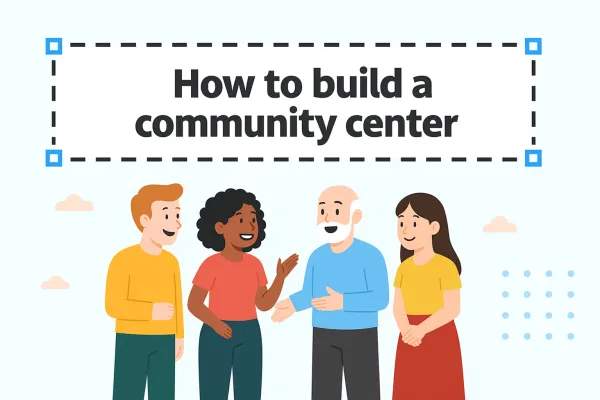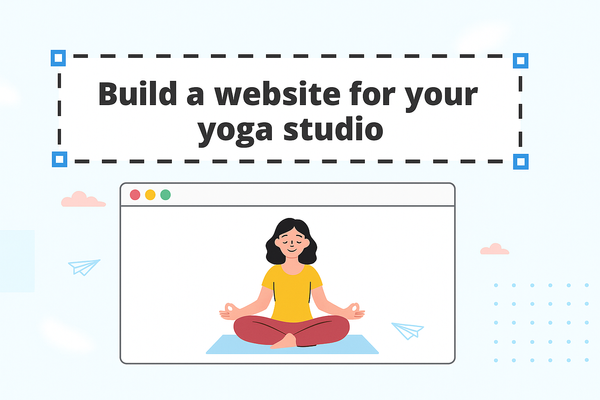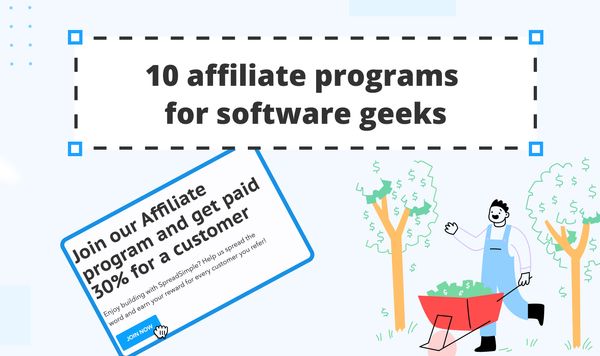SEO Maintenance Checklist for Better Rankings
If you have an online business, chances are you've heard of the game-changing power of SEO (Search Engine Optimization). Simply put, a good SEO strategy increases your visibility online. This means the more people see your website, the more visitors you attract, and your sales and lead generation increase.
When you build a web page, there are two main aspects to consider – search engines and customers. You need an SEO-friendly website to rank higher on search engines and attract consumers to find their products. Mastering SEO without any digital marketing experience can be quite a challenge. So to help you understand it better, in this article, we will look at why SEO maintenance is important and at the different ways to perfect it.
Why SEO is important for website ranking
SEO is the practice of optimizing a website so that it ranks higher on search engines, which today mostly means Google. Your site's ranking with proper SEO maintenance is all about where it stands on the search engine results pages (SERPs). A number one ranking means that when visitors search for a specific keyword, your platform is the first result they see organically after the paid advertisements and that is the goal of every business.
Though paid traffic is good for short-term goals, every business should achieve organic traffic. Appearing in the top 3 results is amazing as your click-through rates are the highest when you are closer to the #1 ranking, as you can see in the image.

Research also shows that 95% of people look only at the first page of search results and about 50% of those clicks go to the first three results. So even if your business web page has a stunning and attractive design, but your ranking is low, your consumers will be unable to find your platform organically via keyword search.
Here are the top benefits of SEO in website ranking:
- SEO increases organic traffic – Organic traffic refers to the visitors who found your web page after searching on engines and clicking on it. This is the best kind of traffic that is needed for brand building and recognition. As we already mentioned, the first search result gets over 50% of the clicks and from there it only reduces. That is why you want to design and optimize a keyword-rich web page that ranks higher on SERPs.
- SEO web page design attracts potential customers – When visitors come to your online platform organically, they hope to find an answer to their query. While they may not convert into a client right away after discovering your web page, they are now aware of your business and will come back, if they have any other related questions. This high-intent traffic is better than other forms of traffic as its conversion rate is higher and this in turn increases sales for your business.
- SEO incorporation improves the user experience – Google has refined its algorithm to include user experience-related metrics as a factor in ranking. By doing so, it ensures its own user experience is top-notch. Improving your website's SEO through proper maintenance is an essential strategy ensuring your web page works well and is easy for a customer to navigate. So having a high-ranking web page also builds trust with your users while helping them find what they are looking for.
- SEO gets the best ROI from your marketing budget – Every dollar invested in SEO brings $100 back, which is a return on investment (ROI) of 9,900%. An SEO strategy can take some time to implement, but the changes are long-lasting and tend to be free. Many businesses can put SEO parameters in place with a little bit of website knowledge. In short, the point is that SEO is a low-cost investment for helping your web page reach its goals and increase ROI.
SEO has been around for almost as long as the internet has been public. Organizations have used strategies to drive traffic to their websites, reach new customers, and initiate growth. With time, SEO has become more sophisticated and technical, changing as per the web users' behavior. Today, we implement both on-page and off-page optimization techniques to ensure high-quality SERP. So let us understand on- and off-page SEO and how to use them.
On-Page SEO checklist
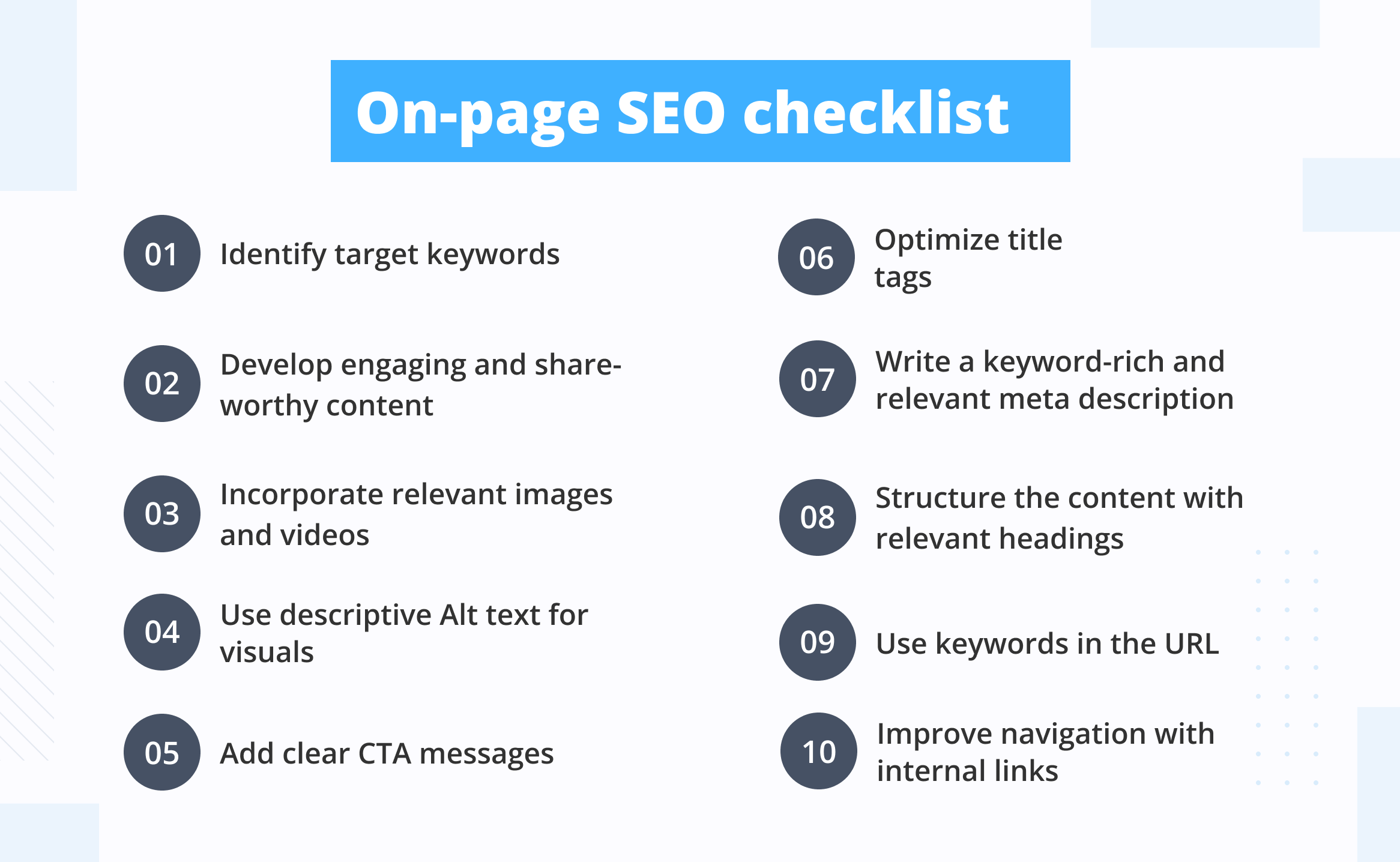
On-page SEO refers to the factors on your website that can be improved. It involves the process of optimizing various front-end and back-end components of your enterprise to increase its ranking on SERPs. As a business owner, you can use content and technical elements to increase the quality of a web page to drive more relevant traffic to it. Here are the important elements of the on-page e-commerce SEO checklist template:
Web page Content
One of the most crucial elements of on-page SEO is your content, as this is what tells the search engine and readers what your online platform and business are all about. Today’s consumers are all looking for relevant, interesting, informative, and keyword-rich content that answers their queries or satisfies their needs. Ultimately, you want to write content that is original and shareable, so that people can repost it, and it reaches more customers. Some ways to write high-quality content are:
- Use short and long-tail keywords in your text.
- Develop content that is engaging and share-worthy.
- Choose the language that your customers are using to describe your products or services.
- Make sure that others can link to your content, which means do not use login and copyrighted material.
- Add relevant images and videos.
- Optimize your conversion by adding CTA to offers and product pages.
The web page content is a way for your company to communicate with search engines and customers. All other on-page SEO maintenance elements stem from high-quality content.
Title Tags
Title tags are HTML elements that give a web page its name or title. They are an important SEO tool as they summarize to both the visitors and search engines what the web page is all about. Some of the key points to keep in mind when developing a title tag are:
- Keep it under 60 characters so that it is not cut out in search results and displays correctly.
- Use focused keywords in the title tag and make sure that they are incorporated as naturally as possible.
- Do not use caps in the title and make it relevant to the website.
- Include your brand name in the title tag.
Each title tag should be unique and descriptive so that it communicates what the web page is about.
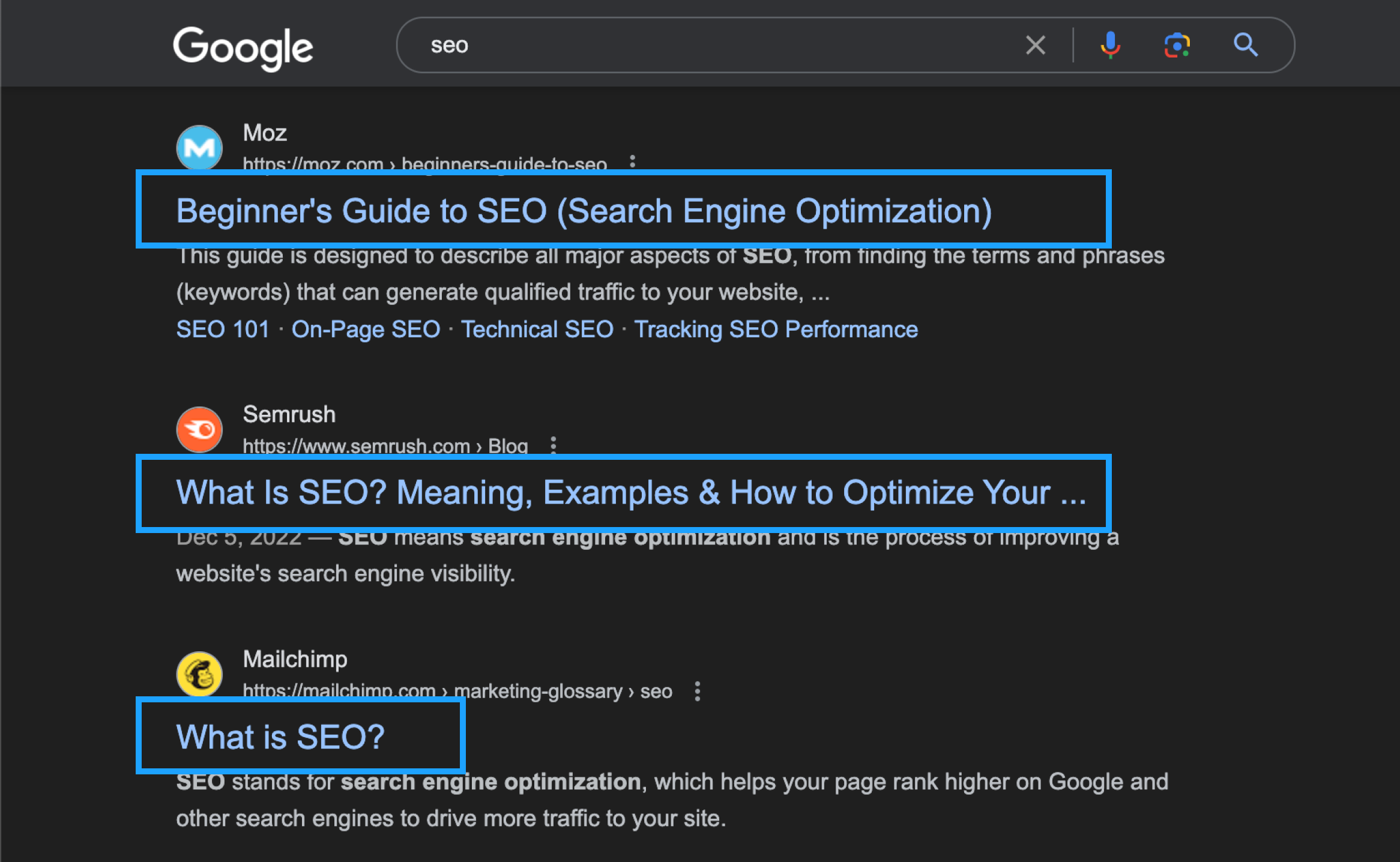
Relevant Headings
Headings, also known as body tags, refer to titles that you give to your content. They are HTML element that organizes your content for readers and helps search engines distinguish what part of your content is relevant and important to the search intent. Headings should be in H1 format for best results and include descriptive words. To break up the content, the use of subheadings such as H2 to H6 is advised. One way to optimize your headings is to include keywords that differ from the ones in the title tag, but make sure not to overload your headings.
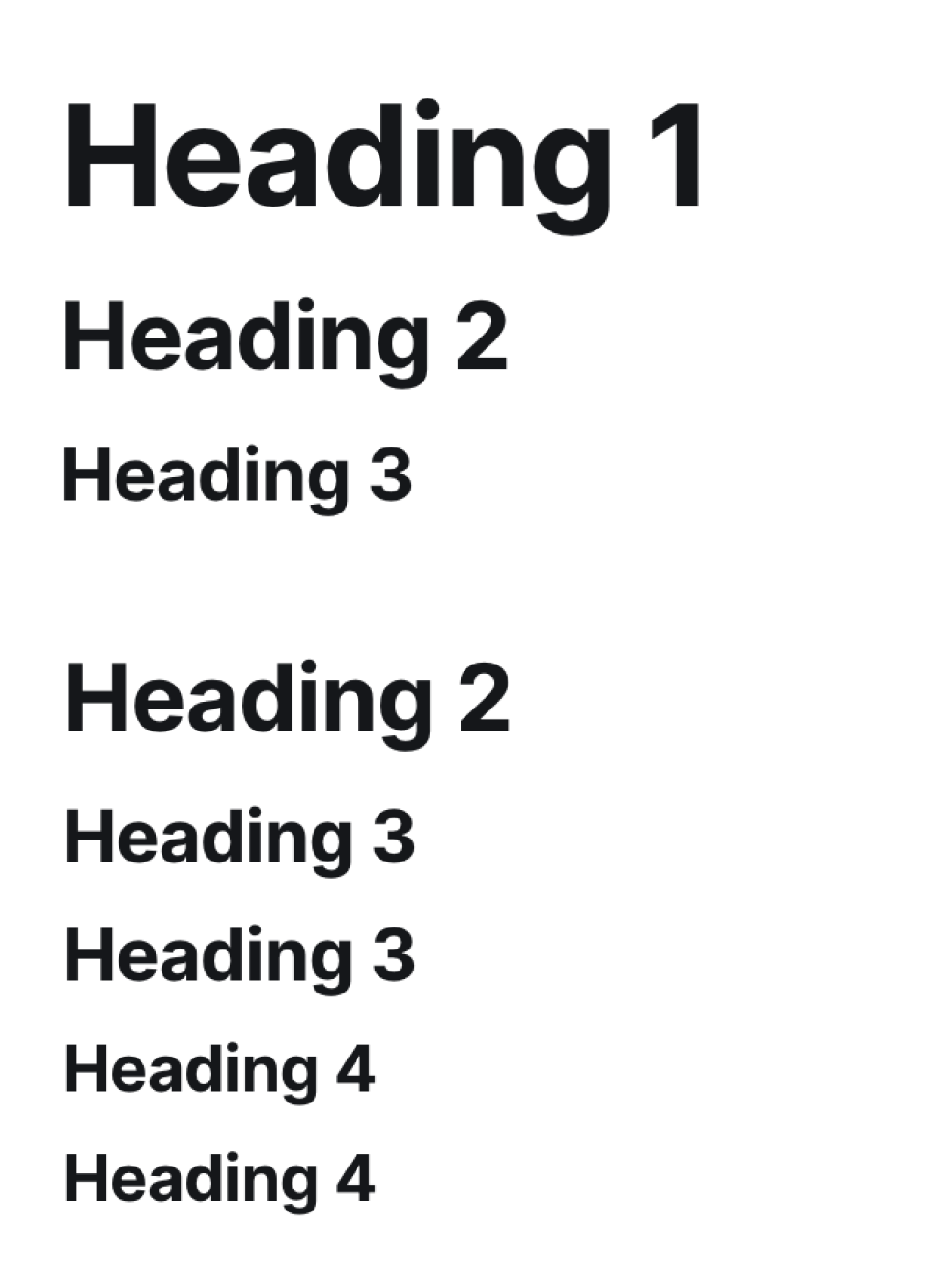
URL Structure
URL structure is an important on-page SEO factor as this helps search engines determine how relevant a web page is concerning the query. Some of the few things to keep in mind when creating the URL structure are:
- Keep it simple to read and remove the extra and unnecessary words.
- Include one or a maximum of two keywords.
- If possible try to incorporate HTTPS in them, as that is a positive ranking factor.
- They should be descriptive of the web page's subject.
A good example of a URL structure would be https://my-directory.spread.name/accessory instead of https://my-directory.spread.name/123456
Images
Images are an SEO factor for your images. It provides search engines with more information about an image and also describes it to visitors who cannot see it. A few key points to remember when creating image alt text are:
- Make them descriptive and specific.
- They should be relevant to the rest of the web page content.
- Keep them shorter than 125 characters.
- Include a few keywords in them.
Google nowadays gives almost the same amount of image-based results as text-based results. That means visitors can discover your website through images too. To take advantage of this, you should include image alt text in your content.
Internal links
Internal linking is the process of hyperlinking your own website's helpful pages. It is an important SEO maintenance factor, as these internal links send readers to other web pages on your domain and keep them engaged longer on your platform. This in turn helps visitors find specific answers to their queries faster and tells search engines that your landing page is valuable and helpful. The longer a person spends on your platform, the more time web search engines have to index your web pages and help you rank higher on SERPs.
Website speed
Website load speed is important, as it helps keep your bounce rate low and search engines like Google put a lot of emphasis on user experience first and foremost. It has been seen that 47% of web surfers expect a page to load in 2 seconds, and 40% of them will leave after the 3rd second.
Internet search engines penalize slow-loading web pages with a lower ranking on SERPs. So it is important to ensure that your web pages load quickly, whether on mobile devices or desktops, as website speed holds a high rank when it comes to on-page SEO.
Check your site's speed anytime using Google's PageSpeed Insights tool.
Cross-Browser Compatibility
In simple words, cross-browser compatibility is the process of ensuring your platform delivers a consistent performance and top-rated user experience regardless of browser choice. As you know there are many search engines, and each of them renders sites differently. Getting your online site to look and work the same regardless of the user's browser requires an understanding of unique browser capabilities and making your web pages compatible by testing and tweaking your code.
Cross-browser compatibility allows a platform to feel and function the same whether a user is viewing it on Chrome, Firefox, Opera, Safari, or Microsoft Edge.
Responsive Design
In recent times, people use mobile devices more often to access the internet than desktops. Responsiveness is a design element that ensures your web page displays properly on any device. It is an important SEO factor, as Google has started favoring business web pages that are optimized for faster loading and better display on mobile devices. So it is important to make your theme, design, website hosting service, and content layout in a mobile-friendly manner.
You can use Google’s Mobile-Friendly Test tool to ascertain your platform’s mobile readiness.
Meta Descriptions
Meta descriptions are the short page explanations that appear under the title in search results. They are brief but vivid descriptions that expand on the title tags and summarize the content in a few lines. This tells the users why they should click and read your information instead of some other business web page. Some ways to make a good meta description are:
- Keep it under 160 characters.
- Incorporate your entire keyword or keyword phrase.
- Avoid using alphanumeric characters like &, +, or –.
- Try to use compelling and relevant sentences.
Though meta descriptions are not an official ranking factor for search engines, they can influence whether your web page is clicked on or not. Therefore, it is very important when applying on-page SEO.
Schema Markup
Schema markup is a method of coding that helps impact how your web pages are visible on search engines. It helps platforms such as Google read and understand your content, as well as embedded qualities like rich snippets to your website display. They consist of HTML tags that are incorporated into your platform’s code and primarily are of two types – JSON-LD and microdata. There are two ways to include schema markup, you can either write it yourself or use a plugin like Yoast to create it for you.
How to optimize a SpreadSimple website
If you have a SpreadSimple website, you can use the SEO settings to make your website more visible and drive more traffic to it. Watch this video to learn more:
Off-Page SEO checklist
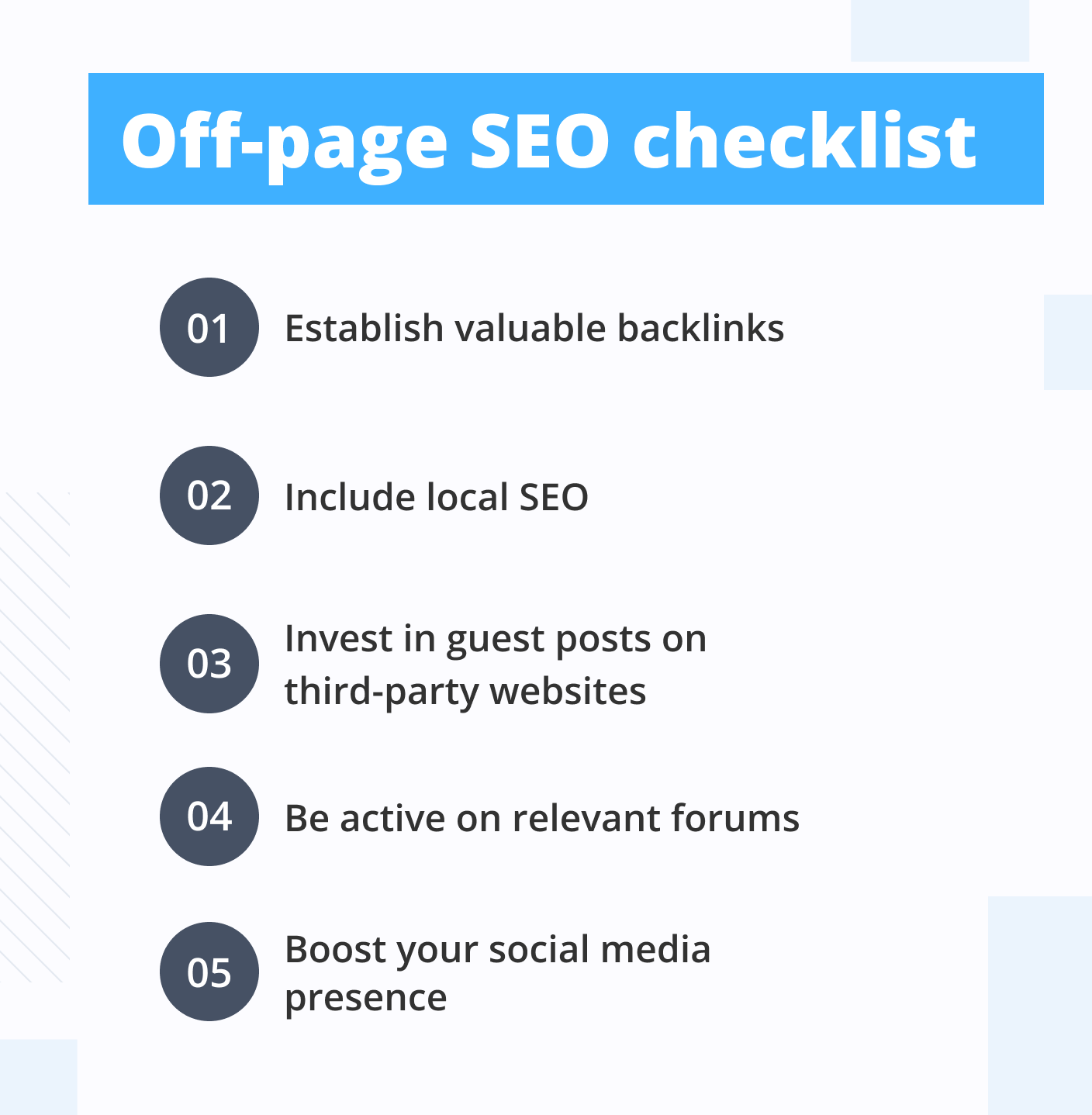
Off-page SEO refers to the actions and steps taken outside of your website to affect the authority and trustworthiness of your business web pages. While most organizations and people focus all their efforts on on-page SEO optimization tactics, it is important to know: that a balanced strategy that combines on-page and off-page SEO is what will increase your SERP ranking. So here are the essential elements of the off-page e-commerce SEO checklist:
Establish valuable backlinks
A backlink is a URL or embedded link of your web page or content in an external third party’s website or online content. It is the backbone of an off-page SEO strategy, as it signals to search engines that a third party finds your content trustworthy and valuable, which in turn increases your ranking in SERPs.
One of the key elements to keep in mind when creating backlinks: quality is more important than quantity, though web search engines take into account both. A single quality backlink from an authoritative site is worth more than 10 low-quality backlinks. Search engines also penalize web pages with irrelevant and fraudulent backlinks.
Include local SEO
Adding your business to local area listings and internet directories such as Google My Business, Yelp, Yellow Pages, and others, is a great way to get more visibility on Google’s local search results. It is important to make sure that the information listed is accurate, and that your business name, address, phone number, and website URL are consistent across all platforms. Also, it is essential to update your information on time. By adopting this off-page SEO strategy you can boost your ranking in your local SERPs.
Guest posts on third-party websites
Some third-party websites accept guest contributions and allow you to add URLs to your guest posts. This is an excellent way to secure valuable backlinks and attract new audiences to your web pages by publishing quality content on third-party online platforms. Another way to boost your credibility is to give positive and helpful contributions in the comments sections of web pages that are of your market niche. Eventually, the users of these sites will notice your contributions and check out your business profile. This increased visibility can multiply your traffic and ranking.
Active Participation in Forums
Forums and discussions on websites like Quora are excellent sources of referral traffic generation. You can participate in discussions and answer questions on forums, especially if you're an expert in your industry. One thing to keep in mind is that you should only post something when you have anything valuable to contribute that pertains to the query. A typical forum user is cynical about self-promotion, so it is advisable to focus on building a positive reputation for resolving questions.
Be active on social media
If you are promoting your content and business on social media, then you are already on the right path. By actively sharing your content on social media platforms, you tend to attract visitors from diverse sources. Some common steps to adopt in social media marketing are engaging with followers on platforms, encouraging third parties to mention your web pages, and responding to every mention of your product or business. These activities indicate to a search engine that your website domain is important and valuable to users and can help increase your ranking.
Google Business Profile
Imagine you reach a boutique shop and it turns out to be closed, even though the opening timings are displayed clearly on Google. It would be a very disappointing feeling. Then you do understand the importance of keeping your Google business profile up to date. It is a task that requires a few minutes every couple of months but has a huge impact on your site reviews.
Some of the things to double-check when updating your profile are:
- Opening and closing hours
- Holiday timings
- Contact number
- Goods and services description
- Using the posts feature, keep your users informed about your promotional offer, etc.
How to measure your SEO progress
SEO strategies are a great way to rank higher in search engine results. With consistent and high-quality SEO content, you ensure that there is a steady flow of customers to your business website. But this requires measuring the progress of your SEO strategies and adjusting them if necessary. So we have compiled a list of the key metrics to monitor that are essential to measuring SEO progress:
Search engine ranking
When you were designing your website, you would have done keyword research and used the most relevant ones in your content. Doing a simple Google search of those keywords and monitoring your ranking is a great way to measure your SEO progress. Taking note of where you stand for certain keywords can help you determine if your SEO strategy is progressing or not.
Monitoring Website Traffic
Monitoring and knowing the different sources of your website traffic, lets you analyze where to focus your attention to drive your ranking. The most important of them is organic traffic. It is the number of visitors who have come to your business platform by doing an online search. Google Analytics can help you segment the sources of your organic traffic and show, where your returning customers are coming from. This way you can focus your attention on those sources to boost traffic.
Click-through rate (CTR)
Click-through rate (CTR) is a performance metric that measures the ratio of clicks on your link to the total number of users who viewed the search results. In simple words, the higher your CTR, the higher will be your traffic. It is an important metric to understand SEO progress as a higher keyword ranking leads to the growth of your CTR. If your website is providing the information needed by the visitors, your CTR should increase consistently.
Bounce Rate
Bounce Rate measures the percentage of how many visitors bounced from your website without taking any action. A high bounce rate can mean that your site is not user-friendly and that you need to correlate your keywords to your content better. A typical bounce rate should be between 40-50%.
Average Session Duration
Average session duration is the metric that tells you how much time your customers are spending on your platform. By monitoring this metric you will be able to assess the quality of your website and understand if you need to implement any changes. One way to grow this metric is to experiment with short and long forms of content and also use images and videos to make your content more engaging.
What are the best tools for SEO maintenance?
If you don’t have time to dedicate to SEO maintenance, fret not. Lots of business owners struggle to support their SEO strategy. Here are some of the best free SEO tools you should be using to optimize your business platform.
- Google Analytics – It is one of the best free SEO maintenance tools in the market today. It provides a lot of relevant data about web pages, such as the number of site visits, traffic sources, location demographics, etc. This valuable information can help you tweak your content strategy and understand what works for you.
- Keyword Planner – Provided by Google, this resource is designed for ad campaigns that you can use for keyword research by seeing how they perform in advertisements.
- Screaming Frog SEO Spider – Browse through your site and detect SEO errors with this tool. It helps discover HTTP header errors, JavaScript rendering hiccups, excess HTML, crawl mistakes, duplicate content, and more.
- Google Trends – This resource can help you see the interest in a particular keyword/term from as recently as an hour to as far back as 2004. You can sort this data by categories, country, and type of search, as well as see related topics, popularity by region, and newest most frequently searched terms.
Besides the above popular resources, we would also like to mention a few others that might benefit your website: Mobile-Friendly Test, Semrush, Chrome DevTools, SEO Minion, Google Search Console, Bing Webmaster Tools, Google Tag Manager, Mobile-Friendly Test, and Page Speed Insights.
SEO tips and tactics
Here are a few tactics you can apply to your web pages for an effective SEO.
Plan your website structure
Making sure your platform is logically structured, helps your visitors to navigate your website better. This also helps search engines to find all the web pages and this in turn helps your enterprise rank better on SERPs.
Doing this is easy enough, just make sure there is an internal link on every page that allows users and search engines to navigate through your platform.
Website downtime
Website downtime can negatively affect a platform's reputation and cause users to leave the site and not continue. Turns out even search engines use downtime as a measure of a platform’s performance. Just make sure you use an application like Pingdom to help you track your site’s downtime. This tool pings your web pages a hundred times per day and notifies you if there is a problem. A reduction in downtime can positively affect your SERPs score.
Update and relaunch outdated content
Just as simple software needs to be updated for better performance, your website content functions in the same way. Making changes, like rebranding the headings, updating the information, and relaunching your web pages, can help you rank better in search engines and also help with SEO. Another great way to achieve this is to go back to your blogs and update their data so that it reflects the current trends and information relevant today.
It has been shown that sometimes simply changing 2-4 things in a blog can increase your web page traffic by 1000%.
Deadweight pages
We have heard the phrase – How quality is better than quantity. Recently Google announced that large websites with lots of web pages can be bad for SEO. These unnecessary pages on a platform are called Dead Weight. They bring the ranking of your brand down on a search engine platform. Some examples of dead-weight pages are:
- Category and tag pages
- Outdated blog posts
- Duplicate content
- Low-quality posts
- Product pages with zero sales
- Archive pages
- Boilerplate content
- Old services pages
Make sure if you have these in your website, to delete and reduce them for better SEO.
Conclusion
SEO is a very competitive business and is ever-changing, based on internet users' behavior. Optimizing your online platform requires you to have a solid strategy in place to combine and implement on- and off-page SEO practices. Even with the above-mentioned checklist, it can take around 6–8 months to see significant results. Building a high-ranking website that drives traffic demands patience, so get started right away, and do not forget to monitor your progress along the way.

Frequently asked questions
What Is Search Engine Optimization (SEO)?
SEO is the practice of optimizing a website so that it ranks higher on search engines, which mostly means Google. Your site's ranking with proper SEO maintenance is all about where it stands on the search engine results pages (SERPs).
Why do we need SEO?
An enterprise needs proper SEO as it is a major factor that affects the website’s visibility online. This in turn also has an impact on conversions, growth, and profitability in the long run.
Why Is SEO an Ongoing Process?
Since the internet is constantly updating, the parameters by which a website’s performance is judged also keep changing. An ongoing SEO strategy will keep your site relevant on SERPs.
How often should I perform SEO maintenance?
Monthly maintenance is mandatory for the effective performance of SEO. But make sure you also do a weekly check for website speed, broken links, and rankings.
Can I do SEO maintenance myself?
Yes, if you are a startup, then using the processes explained above should help you manage your website’s SEO to a great extent. But as you progress in business, it would be advisable to hire professional expertise as that can be invaluable towards your growth. If you have the budget for it, then consider hiring an SEO agency to help you out.
How much does SEO maintenance cost?
If you are managing the SEO maintenance yourself, then the major cost to you would be the time it takes to learn SEO and understand maintenance tasks. Many online softwares offer free trial plans and premium features that require a subscription. If you choose to hire an SEO professional, then your learning curve will be reduced and you will save time. Most agencies charge different figures based on factors like their brand reputation, location, complexity of your website, and amount of work rendered.
